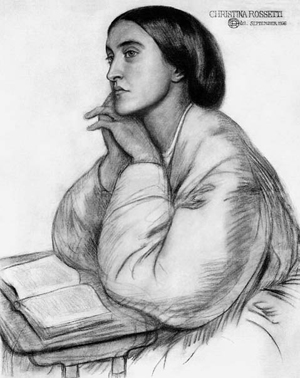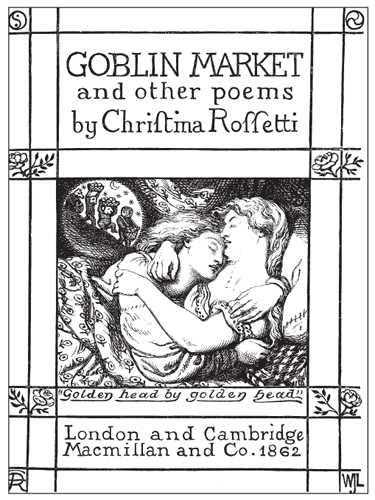Why was the Partridge in the Pear Tree? (15 page)
Read Why was the Partridge in the Pear Tree? Online
Authors: Mark Lawson-Jones


Christina Rossetti sketched by her brother Dante.
Christina Rossetti’s family were well-known poets, artists and critics, and as a child she would have been surrounded by people who were passionate about art, politics and religion. Although she spent most of her childhood in a dark and depressing early Victorian London, she was exposed to nature and the countryside on frequent visits to her grandfather. These themes recur throughout her poetry. Rossetti was healthy as a child, but was often ill during adolescence. She was diagnosed with ‘a kind of religious mania’ which might well have been psychosomatic.
Sketches made of her by her brother Dante, who himself became a famous artist, suggest that she was quite beautiful. At eighteen years old she became engaged to James Collinson, a young painter and member of the Pre-Raphaelite brethren, but the engagement ended after he reverted to Roman Catholicism in 1850. She, and the other Rossetti women, were initially devout evangelical Anglicans, who were eventually drawn to the traditional call of the Tractarians. They did, however, keep their evangelical seriousness. Maria, one of her sisters, became a nun, and Christina’s own religious poetry shows a deep commitment to her faith.
Rossetti continued her association with the Pre-Raphaelite movement. She herself was considered to have achieved the first success of the Pre-Raphaelite writers with the publication of
Goblin Market and Other Poems
in 1862. Rossetti often found herself caught between the worldly and the heavenly and this schism was central to her life and her poetry.
Her brother was able to convince Alexander Macmillan to publish three of Christina’s poems in
Macmillian’s Magazine
. One of the poems ‘Uphill’ was the first to receive attention and remains one of her finest works. This poem is an allegory about salvation, with the end being represented as an Inn.

The title page of the first edition of
Goblin Market.
Another of Rossetti’s poems, ‘The Iniquity of the Fathers Upon the Children’ is a dramatic poem that deals with the issue of illegitimate children, by imagining that she herself is one. She had spent much time in charitable work at a home in Highgate, which was devoted to prostitutes and unmarried mothers. Much of her work at this time dealt with the chasm between the rich and poor, the injustice she witnessed on a daily basis and her desire for a fairer society.
Many writers have questioned what might have been if Rossetti hadn’t been born into the early nineteenth century, where women poets and authors were silenced. In the male-centred culture in which she found herself, Rossetti challenged the status quo, creating her own world-view that provided fertile soil for her poetry and other women of the time. Her achievement cannot be underestimated; it is little known that at one stage she was seriously considered for Poet Laureate. Later in her career, Rossetti abandoned political subjects and concentrated more on the spiritual side of her art.
When her father’s failing health and eyesight forced him to retire in 1853, Christina and her mother supported the family by starting a day school, but had to give it up after a year or so.
In the early 1860s she fell in love with Charles Cayley, who was famous for translating the work of Dante, an Italian poet of the Middle Ages, into English from the original. But according to her brother, William, refused to marry him because ‘she enquired into his creed and found he was not a Christian.’ After this, she lived the life of a Victorian spinster, staying at home with her circle of her brother’s friends which included author of
Alice in Wonderland
, Lewis Carroll; the American artist James Abbott MacNeil Whistler; and the English poet, playwright and novelist Algernon Charles Swinburne.
She continued to write and in the 1870s she worked for the Society for Promoting Christian Knowledge. Her brother Dante suffered a breakdown in 1872, which seriously affected her.
The poem ‘In the Bleak Midwinter’ was almost certainly written by Christina Rossetti around this time. It was published posthumously in 1906 not as a poem, but set to music by the English composer Gustav Holst as possibly one of the most atmospheric and moving Christmas carols of all time. Indeed in 2008, the setting by another English composer Harold Darke, which differs from Holst’s arrangement including a solo as the first verse, was voted the best carol according to the BBC
Music Magazine
, which questioned fifty-one directors of music in the UK and US. The deputy editor, Jeremy Pound, stated that the words were ‘nigh on perfect as a carol text’.
The carol not only sets the Christmas scene in a beautifully descriptive way, it is also a complete guide to the Christian faith at Christmastime. In the first verse, Rossetti paints the picture of the circumstances of the birth of Jesus Christ in Bethlehem.
In verse two, Rossetti contrasts the incarnation with the second coming, stating that the birth was part of a cosmic plan, which would eventually bring about heaven on earth. She also highlights the poverty into which the child was born.
The third verse is a contrast, the cold harshness of the weather outside and the warmth of Mary in the stable. The presence of the animals also underlines the circumstances of the birth.
In the fourth verse, Rossetti gives us a touching picture of Mary kissing Jesus with great affection and a scene of invisible angels celebrating the birth. This reminds us that in the midst of such an important event there is something natural and genuine. This verse might have been a little mysterious for Darke, because it doesn’t appear in his setting.
The final verse is, of course, an echo back to Rossetti’s earlier work. She presents a challenge to those who would profess a faith, encouraging them to turn it to charitable works.
So, why do people suggest this is the best Christmas carol? Could it be the atmospheric scene setting? Could it be the simple but effective theology that explains the significance of the birth of Jesus Christ? Could it be the fact that it makes us think of those who live their lives in poverty, with love but little else to sustain them?
Some have suggested that the carol is ‘depressing’ and a ‘Victorian dirge’, however to many others, ‘In the Bleak Midwinter’ with the music of Holst and the words of Rossetti represents nothing less than the perfect Christmas carol.
This seems a fitting way to end our journey into the world of Christmas carols and songs. In this new millennium, I hope that we can continue to celebrate and enjoy Christmas each year, and feel good will for those around us.
Each Christmas, as the cold bites and bands of people wander the streets to sing carols and songs, we have the chance one again to believe in a better future, whilst enjoying the best of what the past has to offer in our villages, towns and cities. These tunes and lyrics are more than mere songs, they are the glue that can join communities together, creating a sense of shared concern, even if it only until the last cracker is pulled and the last mince pie is eaten.
May God bless you with an outrageously fun-filled Christmas, may you sing all your carols and songs in tune, and may Santa bring you more than you deserve!

First published in 2011
The History Press
The Mill, Brimscombe Port
Stroud, Gloucestershire,
GL5
2QG
This ebook edition first published in 2011
All rights reserved
© Reverend Mark Lawson-Jones, 2011
The right of Reverend Mark Lawson-Jones, to be identified as the Author of this work has been asserted in accordance with the Copyrights, Designs and Patents Act 1988.
This ebook is copyright material and must not be copied, reproduced, transferred, distributed, leased, licensed or publicly performed or used in any way except as specifically permitted in writing by the publishers, as allowed under the terms and conditions under which it was purchased or as strictly permitted by applicable copyright law. Any unauthorised distribution or use of this text may be a direct infringement of the author’s and publisher’s rights, and those responsible may be liable in law accordingly.
EPUB
ISBN
978 0 7524 7750 3
MOBI
ISBN
978 0 7524 7749 7
Original typesetting by The History Press
Ebook compilation by RefineCatch Limited, Bungay, Suffolk